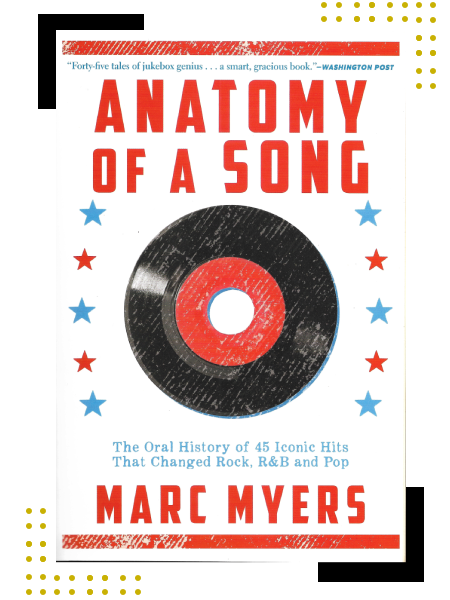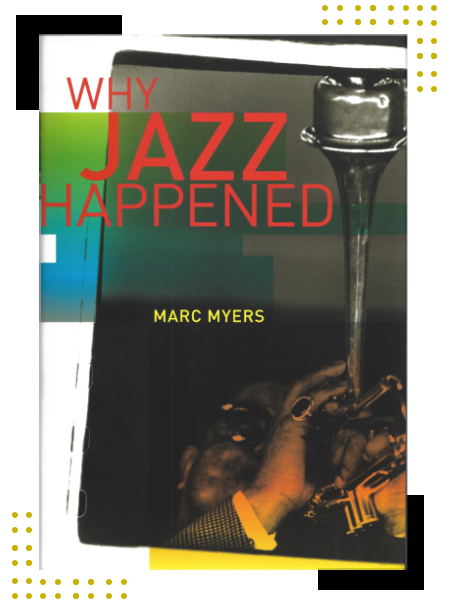Scroll to Learn More...

Songs that sell the most copies become hits, but some of those hits become something more—iconic recordings that not only inspire a generation but also change the direction of music. In Anatomy of 55 More Songs, based on his column for the Wall Street Journal, music journalist and historian Marc Myers tells the stories behind fifty-five rock, pop, R&B, country, and soul-gospel hits through intimate interviews with the artists who wrote and recorded them.
Part oral history, part musical analysis, Anatomy of 55 More Songs ranges from Creedence Clearwater Revival’s “Bad Moon Rising” to Dionne Warwick’s “Walk On By,” The Beach Boys’ “Good Vibrations,” and Black Sabbath’s “Paranoid.” Bernie Taupin recalls the story that inspired the lyrics to Elton John’s “Rocket Man”; Joan Jett describes the rage she channeled into “Bad Reputation;” and Ozzy Osbourne, David Byrne, Elvis Costello, Sheryl Crow, Alice Cooper, Roberta Flack, John Mellencamp, Keith Richards, Carly Simon, and many others reveal the emotions and techniques behind their major works.
Through an absorbing chronological, song-by-song analysis of the most memorable post-war hits, Anatomy of 55 More Songs provides a sweeping look at the evolution of pop music between 1964 and today. This book will change how you listen to music and evaluate the artists who created it.

Between 1950 and 1985, the rock concert developed its allure and power as a unifying experience—and became an influential multi-billion-dollar industry. In Rock Concert, acclaimed interviewer Marc Myers sets out to uncover the history of this compelling phenomenon, weaving together ground-breaking accounts from the people who were there. Myers combines the tales of rock icons with figures such as disc jockeys, rock journalists, promoters, photographers, and fans for a rounded and vivid account of live rock’s stratospheric rise.
Rock Concert provides a fascinating, immediate look at the evolution of live rock performances—spanning from the rise of R&B in the late 1940s and emergence of rock ‘n’ roll in the ’50s, through the hippie gatherings of the ’60s, to the arena and stadium tours of the ’70s and ’80s. Featuring dozens of key players and filled with colorful anecdotes, Rock Concert will speak to anyone who has experienced the transcendence of live rock.
Bob Weir of the Grateful Dead
“The hardest thing about the way we toured was getting up in the morning. We were on the road a lot and our ‘celebrations’ probably made touring more difficult than it had to be. But that was the name of the game for us.”

Joan Baez, folk singer and political activist
“I remember moving all over the place on the Lincoln Memorial as the event unfolded. At one point, I was up high on the steps. I remember seeing Dr. King and a bank of reporters. I had never seen so many, which reinforced what a significant day it was.”

Steve Miller of the Steve Miller Band
“I always referred to my roadies as scurvy pirates. They set everything up, they tore it down, they lived in buses, and they drove all summer long to different venues. I love these guys. I can’t rock and roll without my crew.”

Don Law, New England concert promoter
“People have long assumed that a rock concert business existed from the very start. There was no such thing. The first half of the 1960s was the dark ages. The turning point came in the second half.”

Every great song has a story that needs to be told. In Anatomy of a Song, based on the ongoing Wall Street Journal column, writer and music historian Marc Myers brings to life five decades of music through forty-five transformative songs and oral-history interviews with the artists who created them. Bringing readers inside the making of a hit, Anatomy of a Song includes the Isley Brothers’ memorable song “Shout,” Led Zeppelin’s “Whole Lotta Love,” Janis Joplin’s “Mercedes Benz,” and R.E.M.’s “Losing My Religion.”
After receiving an honorable discharge from the army in 1968, John Fogerty does a handstand and reworks Beethoven’s Fifth Symphony to come up with “Proud Mary.” Joni Mitchell remembers living in a cave on Crete with the “mean old daddy” who inspired her 1971 hit “Carey.” Elvis Costello talks about writing “(The Angels Wanna Wear My) Red Shoes” in ten minutes on the train to Liverpool. And Mick Jagger, the Clash, Jimmy Cliff, Roger Waters, Jimmy Page, Stevie Wonder, Bonnie Raitt, and many other leading artists reveal for the first time the emotions, inspirations, and techniques behind their influential works.
Covering the history of rock, R&B, country, disco, soul, reggae, and pop, Anatomy of a Song is a love letter to the songs that have defined several generations of listeners.

W hy Jazz Happened is the first comprehensive social history of jazz. It provides an intimate and compelling look at the many forces that shaped this most American of art forms and the many influences that gave rise to jazz’s postwar styles. Rich with the voices of musicians, producers, promoters, and others on the scene during the decades following World War II, this book views jazz’s evolution through the prism of technological advances, social transformations, changes in the law, economic trends, and much more.
In an absorbing narrative enlivened by the commentary of key personalities, Marc Myers describes the events and trends that affected the music’s evolution, among them the American Federation of Musicians ban in the early 1940s, changes in radio and concert promotion, the introduction of the long-playing record, the suburbanization of Los Angeles, the Civil Rights movement, the British invasion and the rise of electronic instruments. This groundbreaking book identifies many of the developments outside jazz itself that contributed most to its texture, complexity, and growth.